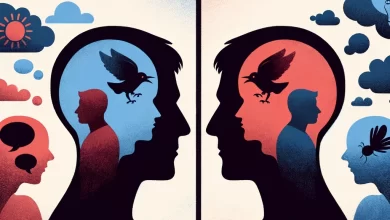Understanding Post Traumatic Stress Disorder PTSD
Have you ever wondered what happens to someone’s mind after experiencing a truly horrifying event? How does it affect their day-to-day life and overall well-being? Post Traumatic Stress Disorder (PTSD) is a mental health condition that delves into the intricate workings of the human mind and the lasting impact that traumatic events can have on an individual.
PTSD is not a mere reaction to stress or a passing emotional state but a complex condition that requires understanding and effective treatment for recovery. From debilitating symptoms to available treatment options, this article aims to shed light on the nature of PTSD and the steps one can take to cope with and manage this condition.
Key Takeaways:
- Post Traumatic Stress Disorder (PTSD) is a mental health condition triggered by a terrifying event.
- Symptoms of PTSD include flashbacks, nightmares, severe anxiety, and uncontrollable thoughts.
- Effective treatment is crucial to reduce symptoms and improve function.
- Psychotherapy and medication are commonly used methods for treating PTSD.
- Timely help and support can prevent normal stress reactions from developing into long-term PTSD.
Overview of Post Traumatic Stress Disorder
Post Traumatic Stress Disorder (PTSD) is a debilitating mental health condition that can occur after experiencing or witnessing a terrifying event. It is characterized by a range of symptoms that can significantly impact an individual’s daily life. While it is normal to have temporary difficulty adjusting and coping after a traumatic event, if these symptoms worsen and persist for months or years, it may be indicative of PTSD.
Managing PTSD requires effective treatment to reduce symptoms and improve overall functioning. This can involve a combination of therapy, medication, and support from mental health professionals and loved ones. Seeking PTSD help is essential for individuals to regain control over their lives and move towards healing and recovery.
PTSD Symptoms
The symptoms of PTSD can vary from person to person but generally fall within four categories: intrusive memories, avoidance, negative changes in thinking and mood, and changes in physical and emotional reactions.
Intrusive Memories
Intrusive memories in PTSD can manifest as recurrent distressing memories, flashbacks, nightmares, and severe emotional distress or physical reactions triggered by reminders of the traumatic event.
Avoidance
Avoidance symptoms involve avoiding thoughts, discussions, places, activities, or people associated with the traumatic event. This avoidance can interfere with the individual’s daily tasks, relationships, and overall quality of life.
Negative Changes in Thinking and Mood
Negative changes in thinking and mood can include negative thoughts about oneself or the world, feelings of hopelessness, memory problems, difficulty maintaining relationships, emotional detachment, loss of interest in activities, and a diminished ability to experience positive emotions.
Changes in Physical and Emotional Reactions
Changes in physical and emotional reactions can manifest as heightened startle responses, hypervigilance, self-destructive behaviors, sleep disturbances, difficulty concentrating, irritability, and a persistent sense of guilt or shame.
Understanding and recognizing these symptoms are crucial steps in managing PTSD. By seeking appropriate help and support, individuals with PTSD can develop healthy coping mechanisms and regain control over their lives.
Symptoms of Post Traumatic Stress Disorder
Post Traumatic Stress Disorder (PTSD) can manifest in various symptoms that can significantly impact an individual’s daily life. These symptoms typically emerge within one month of experiencing a traumatic event. It is important to note that PTSD symptoms can vary both in intensity and duration from person to person.
Intrusive Memories
People with PTSD often experience intrusive memories of the traumatic event. These memories can manifest as distressing flashbacks, vivid nightmares, or uncontrollable thoughts related to the trauma. The intrusive memories can be triggered by reminders of the event, causing severe emotional distress or physical reactions.
Avoidance
Individuals with PTSD may engage in avoidance behaviors as a coping mechanism. This can involve avoiding places, activities, or people that remind them of the traumatic event. Avoidance can interfere with daily tasks, interpersonal relationships, and hinder the healing process.
Negative Changes in Thinking and Mood
PTSD can lead to negative changes in thinking and mood. This may include persistent negative thoughts about oneself or the world, feelings of hopelessness, memory problems, difficulty maintaining relationships, feelings of detachment, lack of interest in previously enjoyed activities, and challenges experiencing positive emotions.
Changes in Physical and Emotional Reactions
Individuals with PTSD may also experience changes in their physical and emotional reactions. These can include increased levels of irritability, easily being startled or frightened, feeling constantly on guard, engaging in self-destructive behaviors, trouble concentrating, difficulty sleeping, and overwhelming guilt or shame.
Understanding and recognizing these symptoms is crucial in seeking appropriate help and support for managing PTSD. While the symptoms can be challenging, there are numerous resources available to assist individuals in coping and recovering from PTSD.
| Symptom Group | Examples |
|---|---|
| Intrusive Memories | Flashbacks, nightmares, uncontrollable thoughts |
| Avoidance | Avoiding places, activities, or people related to the traumatic event |
| Negative Changes in Thinking and Mood | Negative thoughts, hopelessness, memory problems, detachment, lack of interest |
| Changes in Physical and Emotional Reactions | Irritability, easily startled, self-destructive behaviors, trouble sleeping |
Intrusive Memories in Post Traumatic Stress Disorder
Intrusive memories are a common and distressing symptom of post traumatic stress disorder (PTSD). People with PTSD often experience recurrent distressing memories of the traumatic event. These memories can be triggered by reminders such as sounds, smells, or sights associated with the event.
One of the most challenging aspects of intrusive memories is the experience of reliving the traumatic event through flashbacks. During a flashback, individuals may feel as if they are back in the traumatic situation, experiencing the fear, horror, and helplessness all over again. Flashbacks can be overwhelming and disorienting, and they can make it difficult for individuals to distinguish between past and present reality.
Intrusive memories can also manifest as upsetting dreams or nightmares related to the traumatic event. These dreams can be vivid and intensely distressing, often causing individuals to wake up in a state of fear and anxiety. The emotional impact of these nightmares can linger throughout the day, disrupting sleep and contributing to overall distress and exhaustion.
In addition to recurring memories, flashbacks, and nightmares, individuals with PTSD may also experience severe emotional distress or physical reactions when exposed to reminders of the traumatic event. These reactions can be sudden and overwhelming, causing intense anxiety, panic, or a sense of impending doom. Physical symptoms such as increased heart rate, sweating, trembling, and shortness of breath can accompany these emotional reactions.
Managing intrusive memories is an important part of PTSD treatment. Psychotherapy techniques such as cognitive behavioral therapy (CBT) can help individuals develop coping strategies to manage and reduce the impact of intrusive memories. Medications may also be prescribed to alleviate symptoms and improve overall well-being.
Avoidance in Post Traumatic Stress Disorder
Avoidance symptoms are common in individuals with Post Traumatic Stress Disorder (PTSD). These symptoms involve consciously or unconsciously avoiding thoughts, discussions, places, activities, or people that are associated with the traumatic event.
Avoidance can interfere with daily tasks and relationships, making it challenging for individuals with PTSD to lead fulfilling lives. It is crucial to address and manage avoidance symptoms to promote healing and recovery.
Examples of Avoidance Symptoms in PTSD
Here are some examples of avoidance symptoms commonly experienced by individuals with PTSD:
- Avoiding places or situations that remind the individual of the traumatic event.
- Avoiding discussions about the traumatic event or expressing feelings related to it.
- Avoiding activities or hobbies that were once enjoyable but now trigger distressing memories.
- Avoiding people who may remind the individual of the traumatic experience or who were present during the event.
These avoidance symptoms can vary in intensity and may change over time. It’s essential to remember that every individual’s experience with PTSD is unique.
The Impact of Avoidance on Daily Life
Avoidance symptoms can significantly impact a person’s daily life and overall well-being. It can affect relationships, work or academic performance, and participation in social activities.
When someone consistently avoids triggers associated with their trauma, they miss out on opportunities for healing. Avoidance perpetuates fear and can hinder the recovery process.
“Avoidance may provide short-term relief, but it ultimately prolongs the distress caused by PTSD.”
Managing Avoidance in PTSD
Managing avoidance symptoms in PTSD is a vital part of the recovery process. Here are some strategies that can help individuals cope with and overcome avoidance:
- Seek professional help: Collaborate with a mental health professional experienced in treating PTSD to develop a personalized treatment plan.
- Gradual exposure: Work with a therapist to gradually confront triggers and safely expose oneself to the thoughts, emotions, and situations associated with the traumatic event.
- Cognitive restructuring: Challenge negative thoughts and beliefs related to the trauma through therapy techniques like cognitive restructuring.
- Support system: Surround yourself with a strong support system of friends, family, and support groups who can provide understanding and encouragement.
- Self-care: Prioritize self-care activities, such as exercise, meditation, and relaxation techniques, to reduce stress and promote overall well-being.
By actively working on managing avoidance symptoms, individuals with PTSD can gradually regain control of their lives and engage more fully in the world around them.
| Strategies for Managing Avoidance Symptoms | |
|---|---|
| 1. Seek professional help | Collaborate with a mental health professional experienced in treating PTSD to develop a personalized treatment plan. |
| 2. Gradual exposure | Work with a therapist to gradually confront triggers and safely expose oneself to the thoughts, emotions, and situations associated with the traumatic event. |
| 3. Cognitive restructuring | Challenge negative thoughts and beliefs related to the trauma through therapy techniques like cognitive restructuring. |
| 4. Support system | Surround yourself with a strong support system of friends, family, and support groups who can provide understanding and encouragement. |
| 5. Self-care | Prioritize self-care activities, such as exercise, meditation, and relaxation techniques, to reduce stress and promote overall well-being. |
Negative Changes in Thinking and Mood in Post Traumatic Stress Disorder
Post Traumatic Stress Disorder (PTSD) can have a profound impact on an individual’s thinking and mood. The negative changes that occur can significantly affect daily life and overall well-being.
Common Symptoms of Negative Changes in Thinking and Mood
PTSD can manifest in various ways, leading to negative thoughts about oneself or the world. Individuals may experience:
- Feelings of hopelessness and despair.
- Difficulty remembering details or events related to the traumatic experience.
- Struggles in maintaining healthy and fulfilling relationships.
- Feeling detached or emotionally numb.
- Lack of interest or pleasure in previously enjoyed activities.
- Challenges in experiencing positive emotions.
Impact on Daily Life
These negative changes in thinking and mood can significantly disrupt daily life and hinder personal growth and development. Difficulty remembering important details or maintaining healthy relationships can create additional stress and strain on individuals already dealing with the effects of PTSD.
“The negative changes in thinking and mood associated with PTSD can make it challenging for individuals to find joy in life and maintain a positive outlook.” – Dr. Sarah Thompson, PTSD Specialist
Strategies for Coping with Negative Changes in Thinking and Mood
While managing negative changes in thinking and mood can be challenging, there are strategies individuals can employ to cope with these symptoms:
- Seek professional help: Consulting with a mental health professional, such as a therapist or counselor, can provide valuable guidance and support.
- Engage in therapy: Cognitive-behavioral therapy (CBT) and other evidence-based therapies can help individuals challenge negative thoughts and develop healthy coping mechanisms.
- Practice self-care: Engaging in activities that bring joy and pursuing hobbies can help counteract negative thinking patterns.
- Connect with support networks: Seeking social support from friends, family, or support groups can offer encouragement and understanding.
- Practice mindfulness: Techniques such as meditation and deep breathing exercises can help individuals regulate their emotional state and promote a sense of calm.
Strategies for Managing Negative Changes in Thinking and Mood in PTSD
| Strategy | Description |
|---|---|
| Seek professional help | Consulting with a mental health professional, such as a therapist or counselor, for guidance and support. |
| Engage in therapy | Participating in evidence-based therapies, like Cognitive-behavioral therapy (CBT), to challenge negative thoughts and develop healthy coping mechanisms. |
| Practice self-care | Engaging in activities that bring joy and pursuing hobbies to counteract negative thinking patterns. |
| Connect with support networks | Seeking social support from friends, family, or support groups to receive encouragement and understanding. |
| Practice mindfulness | Using techniques like meditation and deep-breathing exercises to regulate emotional state and promote a sense of calm. |
Changes in Physical and Emotional Reactions in Post Traumatic Stress Disorder
Individuals with post-traumatic stress disorder (PTSD) experience a range of changes in their physical and emotional reactions. These symptoms can have a significant impact on their daily lives and overall well-being.
Easily Startled and Always on Guard
A common symptom of PTSD is being easily startled or frightened. Individuals may feel a heightened sense of alertness and constantly be on guard, expecting danger at any moment. This hyperarousal can make it challenging to relax and feel safe in everyday situations.
Trouble Sleeping and Concentrating
Another common change in physical and emotional reactions associated with PTSD is trouble sleeping. Individuals may experience nightmares, insomnia, or other sleep disturbances, leading to fatigue and daytime drowsiness. Additionally, they may have difficulty concentrating on tasks or staying focused due to intrusive thoughts and memories related to the traumatic event.
Irritability and Self-Destructive Behavior
PTSD can also manifest through irritability and self-destructive behavior. Individuals may become easily agitated, have angry outbursts, or engage in risky behaviors as a way to cope with their emotions. These reactions can strain relationships and contribute to feelings of guilt or shame.
Overwhelming Guilt or Shame
Feelings of overwhelming guilt or shame are also common in individuals with PTSD. They may constantly blame themselves for the traumatic event or believe they could have prevented it. These emotions can be debilitating and hinder the healing process.
“It’s crucial for individuals with PTSD to seek professional help and support to better manage these changes in physical and emotional reactions. Treatment options such as therapy and medication can significantly improve their well-being and help them regain control over their lives.” – Dr. Sarah Myers, Psychiatrist
| Changes in Physical and Emotional Reactions in PTSD | Common Symptoms |
|---|---|
| Easily Startled and Always on Guard | Heightened alertness, feeling threatened |
| Trouble Sleeping and Concentrating | Nightmares, insomnia, difficulty focusing |
| Irritability and Self-Destructive Behavior | Agitation, angry outbursts, risk-taking |
| Overwhelming Guilt or Shame | Constant self-blame, feelings of shame |
It’s important for individuals with PTSD to understand that these changes in physical and emotional reactions are a normal response to a traumatic event. By seeking professional help and utilizing effective coping strategies, individuals can regain control over their lives and manage the symptoms of PTSD.
Causes and Risk Factors of Post Traumatic Stress Disorder
Post Traumatic Stress Disorder (PTSD) can develop after experiencing or witnessing an event involving death, serious injury, or sexual violation.
The exact causes of PTSD are unknown, but it may be due to a mix of stressful experiences, inherited mental health risks, temperament, and how the brain responds to stress.
Let’s take a closer look at the risk factors associated with PTSD:
- Intense or prolonged trauma: These can include experiencing or witnessing natural disasters, accidents, or acts of violence.
- Childhood abuse: Individuals who have experienced physical, emotional, or sexual abuse during childhood are at a higher risk of developing PTSD.
- Certain occupations: Military personnel, first responders, and other professions that involve exposure to traumatic events may heighten the risk of developing PTSD.
- Mental health problems: Pre-existing mental health conditions, such as anxiety or depression, can increase vulnerability to PTSD.
- Substance misuse: The misuse or addiction to drugs or alcohol can exacerbate the development and severity of PTSD symptoms.
- Lack of support system: A lack of social support, including family, friends, or community resources, can hinder the ability to cope with and manage the effects of a traumatic event.
- Family history of mental health problems: Having a family history of mental health disorders, such as anxiety or depression, can increase the risk of developing PTSD.
By understanding the causes and risk factors associated with PTSD, individuals and healthcare professionals can better assess and address the condition. Early intervention and appropriate support can significantly improve the management of PTSD and enhance overall well-being.
Complications and Prevention of Post Traumatic Stress Disorder
Post-traumatic stress disorder (PTSD) can have significant complications, affecting various aspects of an individual’s life. It can also increase the risk of developing other mental health problems, such as depression, anxiety, eating disorders, and even suicidal thoughts. Understanding these complications is crucial in managing and preventing the long-term effects of PTSD.
Complications of PTSD
Living with untreated or poorly managed PTSD can have far-reaching consequences. The relentless impact of distressing memories, nightmares, and severe anxiety can disrupt relationships, hinder daily functioning, and impair overall quality of life. Additionally, individuals with PTSD may struggle with self-destructive behaviors, substance abuse, and difficulties in maintaining employment or fulfilling personal goals.
“Living with untreated or poorly managed PTSD can have far-reaching consequences.”
These complications can create a vicious cycle, exacerbating symptoms and making it even more challenging to manage the disorder effectively. Therefore, early intervention and appropriate treatment are essential in minimizing the impact of PTSD on individuals and their loved ones.
Prevention of PTSD
Preventing the development of long-term PTSD after a traumatic event is crucial for promoting emotional well-being and resilience. While it is impossible to prevent all cases of PTSD, there are strategies that can reduce the risk and lessen the severity of symptoms.
Getting timely help and support after a traumatic event is vital. This includes seeking therapy from qualified professionals, such as psychologists or psychiatrists, who can provide evidence-based treatments for PTSD. Therapy options may include trauma-focused cognitive behavioral therapy (TF-CBT), eye movement desensitization and reprocessing (EMDR), or prolonged exposure therapy (PE).
Medical professionals may also prescribe medication to alleviate specific symptoms of PTSD, such as selective serotonin reuptake inhibitors (SSRIs) that can help manage depression, anxiety, or panic attacks. However, medication alone is not a substitute for comprehensive therapy and should be used in conjunction with psychotherapeutic interventions.
Building a strong support system is crucial in preventing and managing PTSD. Friends, family, and support groups can provide understanding, empathy, and a sense of belonging, which can help individuals cope with the emotional challenges that arise from traumatic experiences.
The Centers for Disease Control and Prevention (CDC) offer comprehensive information and resources on PTSD. By utilizing these resources, individuals can gain a deeper understanding of PTSD, its complications, and prevention methods.
| Complications of PTSD | Prevention of PTSD |
|---|---|
| Increased risk of depression | Timely therapy and support |
| Anxiety disorders | Medication for symptom management |
| Eating disorders | Building a strong support system |
| Suicidal thoughts | Seeking evidence-based treatments |
By acknowledging the potential complications of PTSD and actively taking steps to prevent its long-term effects, individuals can regain control of their lives and find a path towards healing and well-being.
Treatment Options for Post Traumatic Stress Disorder
Effective treatment for Post Traumatic Stress Disorder (PTSD) often involves a combination of psychotherapy and medication. These options can help individuals manage their symptoms, improve their overall well-being, and regain control of their lives.
Psychotherapy for Managing PTSD
Psychotherapy, also known as talk therapy, is a common treatment for PTSD. It aims to help individuals identify and change troubling emotions, thoughts, and behaviors associated with their traumatic experiences. One effective psychotherapeutic approach for PTSD is cognitive behavioral therapy (CBT).
Cognitive behavioral therapy focuses on identifying negative thought patterns and behaviors. It helps individuals challenge and replace these thoughts with more realistic and positive ones. CBT also includes techniques to confront and overcome avoidance behaviors related to the trauma.
Eye Movement Desensitization and Reprocessing (EMDR) is another psychotherapeutic technique that has shown promising results in treating PTSD. It involves a combination of cognitive therapy and bilateral stimulation to help individuals process traumatic memories and reduce distressing symptoms.
Group therapy and support groups can also be beneficial for individuals with PTSD. Participating in these supportive environments allows individuals to connect with others who have similar experiences, share their stories, and learn coping strategies from one another.
Medication for PTSD Management
Medication may be prescribed to alleviate the symptoms of PTSD. Selective serotonin reuptake inhibitors (SSRIs) are commonly used to treat PTSD symptoms, such as depression, anxiety, and intrusive thoughts. These medications work by increasing the levels of serotonin in the brain, which helps regulate mood and emotions.
Other types of medication, such as serotonin-norepinephrine reuptake inhibitors (SNRIs) and benzodiazepines, may also be prescribed on a case-by-case basis. It is important to work closely with a healthcare provider to determine the most suitable medication and dosage for an individual’s specific needs.
| Treatment Options | Description |
|---|---|
| Psychotherapy | Talk therapy approaches, like cognitive behavioral therapy (CBT) and eye movement desensitization and reprocessing (EMDR), focus on identifying and changing negative thought patterns and behaviors. |
| Medication | Medications, such as selective serotonin reuptake inhibitors (SSRIs), can alleviate symptoms such as depression, anxiety, and intrusive thoughts. |
| Group Therapy and Support Groups | Participating in group therapy or support groups allows individuals to connect with others who have similar experiences, share coping strategies, and provide mutual support. |
It’s essential for individuals with PTSD to work closely with mental health professionals to determine the most effective treatment plan. Seeking professional help is crucial to ensure the best possible outcome in managing PTSD and improving overall quality of life.
For more information on PTSD treatment options, refer to this comprehensive article that explores various approaches and strategies.
Conclusion
Post Traumatic Stress Disorder (PTSD) is a real and debilitating mental health condition that can be triggered by traumatic events. Understanding the nature of PTSD is crucial for early diagnosis and effective treatment. With the support of mental health professionals, appropriate medication, therapy, and a strong support system, individuals can substantially improve their ability to cope with and manage PTSD.
By seeking timely help and support, it is possible to reduce the symptoms associated with PTSD and enhance overall functioning. It is important to remember that individuals with PTSD are not alone and that there are resources available to provide the necessary assistance. Together, we can create a community that fosters understanding, compassion, and hope for those affected by PTSD.
If you or someone you know is struggling with PTSD, reach out for help. Understanding PTSD and its impact is the first step toward finding the support and resources needed to navigate the challenges and reclaim control. Remember, you are not alone, and there is help available to guide you on your journey toward healing and recovery.






